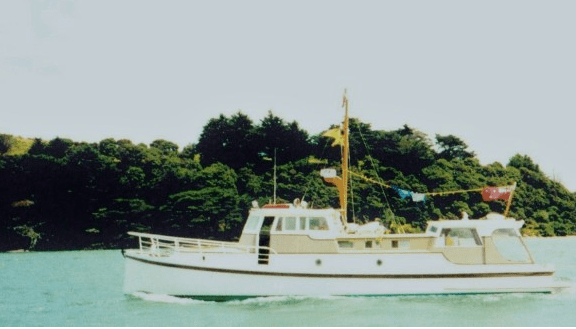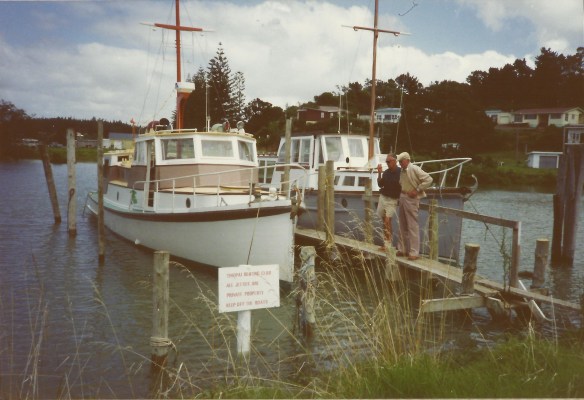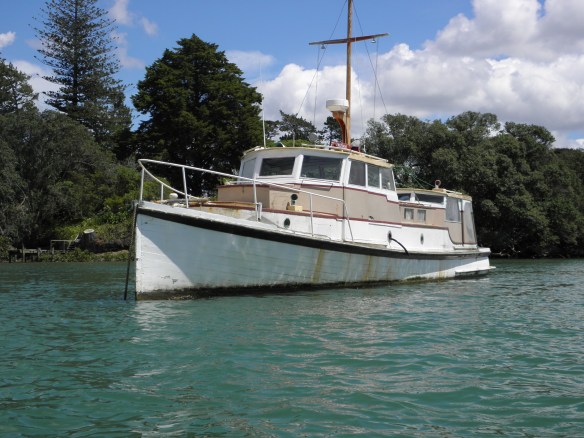

Freedom on the Kaipara

Freedom at Tinopai
ANZAC (Freedom)
photo & details ex Greg Skinner & Zac Matich
All ww knows about Anzac was that she was skippered in the 1920-30’s by Capt. Charles Daniel the father of Greg’s late, great uncle Barney T Daniel. Barney worked for Percy Vos during WW2.
Much later she was renamed ‘Freedom’ & resided on the Kaipara Harbour, owned by Eric Williams of Tinopai.
Can we expand on her history?
Photo (ex Barry Davis) below of Freedom moored off Herald Is. in 2013, was still there 12 months ago.

04-05-2016 – Input from Greg Skinner
Notes form Barley Daniel – “A Kiwi Journal”
“The position my father now had as inspector of fisheries required him plus a mate to patrol the fishing fleets of Auckland and protect the oyster beds from the depredations of those who liked their oysters straight off the rocks and down their gullets. If caught by the Inspectors, these could be costly as a fine of up to 10/- would be imposed on the offender. This was only a part of his duties, however, and to assist in these operations he was supplied with a 40 foot launch called the “Anzac” powered with a 30 or 40 H.P. Doman petrol engine having a fair turn of speed, being a bit narrow gutted, however, and without much protection for the helmsman as she had no canopy over the open cockpit. This matter was rectified later and this improved conditions for those aboard very considerably. Panmure had been chosen as it was a basin that was an offshoot of the Tamaki River providing good anchorage for the “Anzac” plus an area where boats and gear could be stored, etc
After Christmas as a rule all the family, plus Spot the dog and a stray cousin, embarked in the Anzac for some cruising around the Hauraki Gulf. The Anzac was ideal for this and we lived to some degree on the best, fish being plentiful and varied with plenty of fresh vegetables which the Captain had given to him at most spots where we chose to anchor for the night, being well-known to most people around the Gulf, and in return he had fish to give these good folk or perhaps a dogfish or so to bury in their gardens or under a fruit or lemon tree.
The Captain’s assistant usually at this time took his annual leave so we usually spent about three weeks away, the Captain’s duties of patrolling the vast areas of oyster beds kept us on the move so that we covered quite a bit of the Gulf, rarely spending more than one night or perhaps two in the same spot. The temptation to poach oysters, all Government controlled, proved too much for some people, particularly the day tripper.
About this time of the year, of course, there were many day excursions by ferry boat to places like Motutapu, Islington Bay, Browns Island, Motuhie, Motutapu, etc., sometimes up to 2000 people would be disgorged onto these beaches half of whom would be children, as a prime outing for all the family this was hard to beat and cheap into the bargain. The old man had a system worked out for the apprehension of poachers which he leisurely put into effect after lunch, by which time the day trippers had a full belly and time on their hands to sample a couple of dozen oysters.
These forays, of course, were frowned upon by the Marine Dept. and notices to this effect were prominently displayed, adding that a fine of £10 was liable if transgressors were caught in the act. Whenever this happened the sheer size of the Captain was frightening enough to the average poacher so they gave in pretty easily. I think he gave more warnings than summonses as the latter meant a court appearance for him as prosecutor and was a time-wasting device according to him.
It was not long after the above episode that the Dept. installed a brand new three cylinder 30H.P. Twigg engine, this was one of the last of its type produced by Twiggs of Auckland, it was a massive piece of cast iron painted green, reliable, economic, and suited to run at very low revolutions without fuss for hours on end, most of the Fisheries Dept. vessels had them installed and were still going up until the ‘50s.
The Anzac with her new engine took on a new lease of life and never had cause to raise doubt in the minds of her crews when the going got a bit on the hairy side. These engines were remarkably simple, they ran on benzine and had magneto ignition, were salt water cooled, and there must have been some special cast iron in their construction that was impervious to salt, the cooling circulating water around the blocks and heads cooled the exhaust manifold and finally was discharged via the exhaust system to atmosphere or more correctly at about the water line of the hull. They were very quiet running and it was no trouble to imitate the sound which went something like “Chugga ta chug”, “chugga ta chug”. The benzine of those days came in case lots, two four gallon tins to each case so the cases once used came in for a variety of uses of a permanent nature whilst the tins lent themselves to a multitude of ideas both decorative and useful.
Living aboard Anzac was pretty simple, cooking was done in a galley with a couple of primus stoves, the washing-up done in a basin or bucket in the cockpit, it did have a patent lavatory but was used only in emergency being frowned upon by the Captain as another thing that could go wrong and finally sink the ship. Lighting was Kerosine lamps or lanterns and all these chores were my responsibility as “bucko” when away. It was only natural that my education in ship-keeping was undertaken both by the Captain and his mate so you learnt quickly and early that of the two methods of doing things aboard a ship, it was wise to concentrate on the right way and thus escape the wrath of either of those two worthies when the wrong way was indulged.”
Discover more from waitematawoodys.com #1 for classic wooden boat stories, info, advice & news - updated daily - 14+ million views
Subscribe to get the latest posts sent to your email.




Colin – Sounds like your putting your hand up to hold the dolly – your brother, David, has given the excuse that he didn’t spend enough time at the boat builders yards at Northcote as a child so does not poses the necessary skills, but I am sure he has the ‘Daniel eye’ which is very good at spotting error then pointing out the ‘correct way’ it should be done.
She is currently stripped out. I am in the process of cleaning the inside ready for rib replacement, the wheel house, motor, tanks, fittings and a lot of paint have all been removed, almost at the reassembling phase! – check out this link http://www.kaurilaunch-anzac.com/
LikeLike
Hi Greg, Colin Daniel here, of the Northcote Daniel Family, Davids brother. I think it`s absolutely amazing that you`ve located and saved the ” Anzac ” and are in the process of giving her / him / it a new life. I like the idea of removing the additional cabin top to restore the profile Anzac had back in the day when the Captain operated the craft. I think you deserve a big pat on the back for the undertaking of this quite momentous task in carrying out this restoration. Best Regards, Colin.
LikeLike
Pingback: Boyhood memories of the Hauraki Gulf | waitematawoodys.com #1 for classic wooden boat stories, info, advice & news
Sure – drop me a line on gregandjayne26@gmail.com
LikeLike
Good to hear would love to have a look sometime,am also stationed in helensville
LikeLike
At my own place outside the “Ville” – I have plenty of room on my property – currently it has only stopped raining once in the last month so only mostly interior stripped and fittings removed from the exterior.
Currently a part blessing that I am cracking on with interior as “You will be sleeping in her” says the wife “if it is not finished on time!”
The idea is to put her back on the Waitemata, I guess she has spent half her life in both the Waitemata and the other half on the Kaipara. (both of these harbours have played major parts in my family’s and ANZAC’s history (both the Stanaway’s and the Daniel’s).
LikeLike
Where in helensville are you doing the refit?
Will she stay on the Waitemata?
LikeLike
Yes – will be removing the wheel house which currently sits mid-ships (I see some issues as this is where the motor and fuel tank where conveniently located under the floor), will raise the canopy at the stern another 2-300mm. The idea is to get her back close to her original – but with a few mod-cons. I believe the mast is one of the 2 original masts cut down some – I will relocate this in the original forward location. She has now been mostly stripped out, there are a number of frames to be replaced and a few boards – but still 100+ years of muck to be cleaned and scrapped off first. I have tracked down some previous owners who may still have odd bits from her which I will get my hands on shortly.
LikeLike
Fantastic news. Shaving the cabin off to original?
LikeLike
ANZAC/Freedom now purchased by myself and moved from her mooring – settling down in Helensville undergoing a complete over hall – target re-launch Summer of 2017-18 (I reserve the right to over run said target date) – I plan to re-rename her ANZAC (sorry Eric).
LikeLike
Go to the main post on Anzac to read a great tale on Anzac from Barley Daniel – “A Kiwi Journal” Alan H
LikeLike
I think we’ve been here before. ANZAC was built by Bailey & Lowe in the winter of 1911 for Alex Donald as MAPUHI with a 40hp Wolseley engine. He sold her to Alex Burt Jr (of A. & T. Burt) in late 1913 and he renamed her OBAN. After Gallipoli, Burt renamed her ANZAC. Burt sold her to the Government for use as a Fisheries Inspection Vessel under Capt Daniel in the early 1920s. By then she had a 35hp Doman. Eventually she went to the Kaipara where she was renamed BETTY, then FREEDOM.
That’s the bones of her history.
LikeLike
Any idea who the current owners are?
LikeLike
Eric Williams at Tinopai would know her complete history if anyone wanted to contact him. I now have my launch Gyspy Rose moored in the same place where Eric kept the Freedom
LikeLike
freedom is moored at herald still she was in good condition about 10 years ago and was been used a lot but sadly she has not moved much in the last 9 years good looking boat it is shame to see her like that.
LikeLike
she’s still there as of 2 weeks ago and her state hasn’t improved one bit.
LikeLike
Not exactly history but she currently sitting on a mooring off herald island awaiting a new owner with some time and money.
Sadly I have watched her deteriorate over the last 6 years. Sign says Bailey n Lowe 1907?
LikeLike